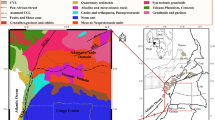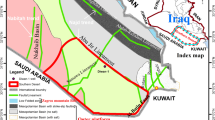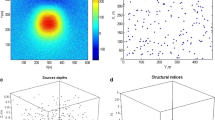Abstract
Edge detection is an important part of interpreting potential field geophysics data. It helps better recognition of magnetic anomaly features such as superficial position and shape. Many edge detection methods have been presented; however, due to the natural complexity of subsurface features, only a few of the processing techniques might be accurate. Because, in practical cases, multi-dimensional precision is essential, using other methodologies along with edge detection can be useful. As a new research, this study utilized the 3D inverse modeling procedure as a confirmation and completion tool for combining both subsurface magnetic susceptibility distribution and surface anomaly projection. This research focused on investigating simultaneous application of 3D inversion and edge-detecting methods that provide an accurate perspective view of sought sources with high magnetic susceptible properties. To perform the mentioned task, along with the definition of two new edge detection filters, some beneficial edge detection filters were implemented on synthetic data. Then, these filters were applied to the Charmaleh Iron deposit magnetic data to obtain a valid anomaly edge perimeter. Subsequently, a 3D inverse modeling scheme was run on the data to investigate the magnetic susceptibility properties of surface and underground structures. In order to validate our edge detection results and to achieve a proper interpretation, the utilized edge detectors and the inverted model results were overlaid, compared, and depicted concurrently. Drilling operations were also conducted within the jointly achieved favorable zones, which were in line with the research findings. Conclusively, it can be stated that joint consideration of the mentioned approaches can be advantageous attitude toward accurate interpretation of environments with highly magnetic anomalies.



















Similar content being viewed by others
References
Abedi, M., & Oskooi, B. (2015). A combined magnetometry and gravity study across Zagros orogeny in Iran. Tectonophysics, 664, 164–175.
Afshar, A., Norouzi, G. H., Moradzadeh, A., & Riahi, M. A. (2018). Application of magnetic and gravity methods to the exploration of sodium sulfate deposits, case study: Garmab mine, Semnan, Iran. Journal of Applied Geophysics, 159, 586–596.
Aghanabati, A. (2004). Geology of Iran. Geological survey of Iran.
Arisoy, M. O., & Dikmen, U. (2013). Edge detection of magnetic sources using enhanced total horizontal derivative of the tilt angle. Bulletin of the Earth Sciences Application and Research Centre of Hacettepe University, 34(1), 73–82.
Azadi, M., Abedi, M., & Norouzi, G. H. (2021). Two-step inversion of airborne geophysical data: a stable downward continuation approach for physical modelling. Acta Geophysica, 70, 1–19.
Blakely, R. J. (1995). Potential theory in gravity and magnetic applications. Cambridge University.
Cooper, G. R. J. (2019). The downward continuation of aeromagnetic data from magnetic source ensembles. Near Surface Geophysics, 17(2), 101–107.
Cooper, G. R. J., & Cowan, D. R. (2004). Filtering using variable order vertical derivatives. Computers & Geosciences, 30(5), 455–459.
Cooper, G. R. J., & Cowan, D. R. (2006). Enhancing potential field data using filters based on the local phase. Computers & Geosciences, 32(10), 1585–1591.
Cooper, G. R. J., & Cowan, D. R. (2008). Edge enhancement of potential-field data using normalized statistics. Geophysics, 73, H1–H4.
Cordell, L. (1979). Gravimetric expression of graben faulting in Santa Fe Country and the Espanola Basin. In New Mexico Geological Society Guidebook, 30th field conference, New Mexico, 1979.
Cordell, L., & Grauch, V. J. S. (1985). Mapping basement magnetization zones from aeromagnetic data in the San Juan Basin, New Mexico. In The utility of regional gravity and magnetic anomaly maps (pp. 181–197). Society of Exploration Geophysicists.
Cowan, D., & Cooper, G. (2005). Separation filtering using fractional order derivatives. Exploration Geophysics, 36(4), 393–396.
Ferreira, F. J. F., de Souza, J., Bongiolo, AdBe. S., & de Castro, L. G. (2013). Enhancement of the total horizontal gradient of magnetic anomalies using the tilt angle. Geophysics, 78(3), J33–J41.
Fournier, D. (2015). A cooperative magnetic inversion method with Lp-norm regularization. MSc. thesis, The University of British Columbia.
Fournier, D. (2019). Advanced potential field data inversion with lp-norm regularization. PhD thesis, The University of British Columbia.
Guo, L., Gao, R., Meng, X., & Zhang, G. (2015). A hybrid positive-and-negative curvature approach for detection of the edges of magnetic anomalies, and its application in the South China Sea. Pure and Applied Geophysics, 172, 2701–2710.
Hansen, P. C., & O’Leary, D. P. (1993). The use of the L-curve in the regularization of discrete ill-posed problems. SIAM Journal on Scientific Computing, 14(6), 1487–1503.
Hosseini, S. H., Dehkordi, B. H., Abedi, M., & Oskooi, B. (2021). Implications for a geothermal reservoir at Abgarm, Mahallat, Iran: Magnetic and magnetotelluric signatures. Natural Resources Research, 30(1), 259–272.
Hsu, S. K., Sibuet, J. C., & Shyu, C. T. (1996). High-resolution detection of geologic boundaries from potential-field anomalies: An enhanced analytic signal technique. Geophysics, 61(2), 373–386.
Li, Y., & Oldenburg, D. W. (1996). 3-D inversion of magnetic data. Geophysics, 61(2), 394–408.
Li, Y., & Oldenburg, D. W. (1998). 3-D inversion of gravity data. Geophysics, 63(1), 109–119.
Ma, G. (2013). Edge detection of potential field data using improved local phase filter. Exploration Geophysics, 44(1), 36–41.
Ma, G., Huang, D., & Liu, C. (2016). Step-edge detection filters for the interpretation of potential field data. Pure and Applied Geophysics, 173, 795–803.
Miller, H. G., & Singh, V. (1994). Potential field tilt—a new concept for location of potential field sources. Journal of Applied Geophysics, 32(2–3), 213–217.
Nabighian, M. N. (1972). The analytic signal of two-dimensional magnetic bodies with polygonal cross-section: Its properties and use for automated anomaly interpretation. Geophysics, 37(3), 507–517.
Nabighian, M. N. (1974). Additional comments on the analytic signal of two-dimensional magnetic bodies with polygonal cross-section. Geophysics, 39(1), 85–92.
Nabighian, M. N. (1984). Toward a three-dimensional automatic interpretation of potential field data via generalized Hilbert transforms: Fundamental relations. Geophysics, 49(6), 780–786.
Oldenburg, D. W., & Li, Y. (2005). Inversion for applied geophysics: A tutorial. Investigations in Geophysics, 13, 89–150.
Oskooi, B., & Abedi, M. (2015). An airborne magnetometry study across Zagros collision zone along Ahvaz-Isfahan route in Iran. Journal of Applied Geophysics, 123, 112–122.
Pham, L. T., Van Vu, T., Le Thi, S., et al. (2020). Enhancement of potential field source boundaries using an improved logistic filter. Pure and Applied Geophysics, 177, 5237–5249.
Poulet, T., D’Escrivan, H., Boschetti, F., Hornby, P., & Horowitz, F. G. (2001). New advances in the analysis of potential field data by multiscale edges. Brisbane: ASEG.
Verduzco, B., Fairhead, J. D., Green, C. M., & MacKenzie, C. (2004). New insights into magnetic derivatives for structural mapping. The Leading Edge, 23(2), 116–119.
Vogel, C. R. (2002). Computational methods for inverse problems. Society for Industrial and Applied Mathematics.
Yao, Y., Huang, D., Yu, X., & Chai, B. (2016). Edge interpretation of potential field data with the normalized enhanced analytic signal. Acta Geodaetica et Geophysica, 51(1), 125–136.
Acknowledgments
The authors would like to express their sincere thanks to the Department of Minining and Metallurgical Engineering, Amirkabir University of Technology and the School of Mining Engineering, University of Tehran for all supports and utilities provided freely for fulfillment of this research. We also thank Prof. Carranza and wish to thank the anonymous referees for providing many insightful remarks that considerably helped us to improve the work. Finally, CEO of Madan Sanat Ruidar Company, Mr Farzad Safaei Zadeh is appreciated for financial support of field survey.
Author information
Authors and Affiliations
Corresponding author
Rights and permissions
Springer Nature or its licensor (e.g. a society or other partner) holds exclusive rights to this article under a publishing agreement with the author(s) or other rightsholder(s); author self-archiving of the accepted manuscript version of this article is solely governed by the terms of such publishing agreement and applicable law.
About this article
Cite this article
Ghiasi, S.M., Hosseini, S.H., Afshar, A. et al. A Novel Magnetic Interpretational Perspective on Charmaleh Iron Deposit Through Improved Edge Detection Techniques and 3D Inversion Approaches. Nat Resour Res 32, 147–170 (2023). https://doi.org/10.1007/s11053-022-10135-7
Received:
Accepted:
Published:
Issue Date:
DOI: https://doi.org/10.1007/s11053-022-10135-7




